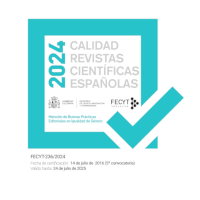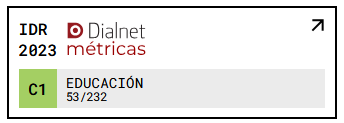The sun of tradition and ecocriticism
animated ecologies and their ancestral roots: legendary and literary ecofictions
DOI:
https://doi.org/10.18172/con.5634Keywords:
animated ecologies, numen aquae, ecofictions, water imaginariesAbstract
Currently, the importance of heritage and biocultural memory and, specifically, of traditional and local wisdoms that are expressed in a particular way in legends and other eco-fictions, both in the corpus of folkloric texts and in literary or multimodal texts, is out of the question. There are several paradigms of study, from ecocriticism to other currents, and therefore, the paper aims to make visible the ancestral wisdom in a specific field, which is the imaginary of water, and from a comparative perspective that allows comparing the different discourses alluded to. In particular, we try to explain the animated ecologies through the numenes aquae or personifications/deities of water that are the axis of such ecofictions, looking for patterns and correlations beyond the local context, and relating this humanization of water with the uses and keys symbolic of water culture.
Downloads
References
Abram, D. (2012). The spell of the sensuous: Perception and language in a more-than-human world. New York: Vintage.
Barlow, M. (2008). El agua, nuestro bien común: hacia una nueva narrativa del agua. México DF: The Council of Canadians, Fundación Heinrich Böll.
Barriga Galeano, E., Martos Núñez, E. y Palmer, I. (2019). La tradición y sus metamorfosis fílmicas: El manantial de la doncella, de Ingmar Bergman. Imaginarios de la naturaleza y de la cultura del agua: Paradigmas científicos y planteamientos didácticos. Madrid: Marcial Pons, 113-121.
Bravo Gaviro, A. (2019). Mitologías de la naturaleza en El Señor de los Anillos y su proyección didáctica”. Tejuelo. Didáctica de la lengua y la literatura. Educación, 29, 161-186.
Bueno, G. (1996). Sobre la realidad de los númenes animales en la religiosidad primaria, El Basilisco, 20, 87-88.
Campos Fernández-Fígares, M. y García Rivera, G. (2017). Aproximación a la ecocrítica y la ecoliteratura: literatura juvenil clásica e imaginarios del agua”. Ocnos, 16(2), 95-106. https://doi.org/10.18239/ocnos_2017.16.2.1511 DOI: https://doi.org/10.18239/ocnos_2017.16.2.1511
Cantero Martín, P. A. (1992). Las tramas del agua. El agua como metáfora viva, González Alcantud, J. A. y Malpica Cuello, A. (Coords.), El agua. Mitos, ritos y realidades, Barcelona, Anthropos, 166-189.
Castoriadis, C. (1997). El imaginario social instituyente. Zona erógena, 35, 1-9.
Çay, M. (2021). Tainted Away: Violence Over Nature in the Anime of Hayao Miyazaki. Handbook of Research on Aestheticization of Violence, Horror, and Power. IGI Global, 259-279. DOI: https://doi.org/10.4018/978-1-7998-4655-0.ch014
Clendenon, C. (2009). Karst hydrology in ancient myths from Arcadia and Argolis, Greece, Acta Carsologica, 38(1), 144-154. https://doi.org/10.3986/ac.v38i1.143 DOI: https://doi.org/10.3986/ac.v38i1.143
Crate, S. (2011). A political ecology of “water in mind”: attributing perceptions in the era of global climate change. Weather, Climate, and Society, 3(3), 148-164. https://doi.org/10.1175/WCAS-D-10-05006.1 DOI: https://doi.org/10.1175/WCAS-D-10-05006.1
Cutchin, J. (2016). Un banquete troyano: extraterrestres, seres elementales y bigfoots. Diversa Ediciones.
Dinzelbacher, P. et al. (2006). Frau Holle, Frau Percht und verwandte Gestalten, 160 Jahre nach Jacob Grimm aus germanistischer Sicht betrachtet. Stuttgart: Hirzel.
Dwyer, J. (2010). Where the wild books are: A field guide to ecofiction. University of Nevada Press.
Ferry, L. (1995). The new ecological order. University of Chicago Press.
Frost, M. y Lynch, D. (1990). Twin Peaks, film, USA, Lynch/Frost Productions.
Gimbutas, M. (1989). The language of the goddess: Unearthing the hidden symbols of western civilization. San Francisco: Harper & Row.
Glotfelty, Ch. y Fromm, H. (Eds.). (1996). The ecocriticism reader: landmarks in literary ecology. University of Georgia Press.
Gunkel, H. (1901). Génesis. Gotinga: Vandenhoeck & Ruprecht.
Harmanşah, Ö. (2018). Geologies of Belonging: The Political Ecology of Water in Central Anatolia. Water and Power in Past Societies, Albany NYP, 259-276.
Harmansah, Ö. (2015). Place, memory and healing. Londres: Taylor & Francis.
Illich, I. (1986). Ideas in progress H2O and the waters of forgetfulness. Londres: Marion Boyars P.
Keetley, D. y Sivils, M. W. (2017). Introduction: Approaches to the ecogothic. Ecogothic in nineteenth-century American literature. Oxfordshire: Routledge, 1-20. DOI: https://doi.org/10.4324/9781315464930-1
Kozel, S. (2012). Geopoética das paisagens: olhar, sentir e ouvir a “natureza. Caderno de Geografia, 22(37), 65-78.
Lakoff, G. y Johnson, M. (1991). Metáforas de la vida cotidiana. Madrid: Cátedra.
Lecouteux, C. (1999). Hadas, brujas, y hombres lobo en la Edad Media. Madrid: Olañeta.
Leff, E. (2003). La ecología política en América Latina. Un campo en construcción. Polis. Revista Latinoamericana, 1(5). https://www.redalyc.org/articulo.oa?id=30500505 DOI: https://doi.org/10.1590/S0102-69922003000100003
Linton, J. (2010). What is water? The history of a modern abstraction. UBC Press. DOI: https://doi.org/10.59962/9780774817035
Martínez Dueñas, W. (2012). Quand H2 O et esprit de l’eau se rencontrent: Coexistence de plusieurs mondes à Puracé, Colombie. Recherches amérindiennes au Québec, (42)2-3, 39-47. https://doi.org/10.7202/1024101ar DOI: https://doi.org/10.7202/1024101ar
Martos, A. y Martos, A. E. (2018). Imaginarios y leyendas marianas iberoamericanas y su matriz circumatlántica: el caso de Stella Maris y la Virgen del Carmen. Acta Scientiarum. Language and Culture, (40)2. DOI: https://doi.org/10.4025/actascilangcult.v40i2.35825
Martos García, A. (2016). Las sirenas como arquetipos transculturales y como recurso para la educación literaria. Didáctica: Lengua y Literatura, 28, 181-199. DOI: https://doi.org/10.5209/DIDA.54081
Martos García, A. (2018). El giro ontológico en las lecturas de la Naturaleza: propuestas de intervención didáctica. Álabe. Revista De Investigación Sobre Lectura Y Escritura, 17. http://doi.org/10.15645/Alabe2018.17.1 DOI: https://doi.org/10.15645/Alabe2018.17.1
Martos García, A. (2021). Lecturas ecológicas: hacia un canon de ecolecturas. Educatio Siglo XXI, 39(1), 191-210. https://doi.org/10.6018/educatio.469231 DOI: https://doi.org/10.6018/educatio.469231
Martos García, A. y Martos García, A. E. (2015). Nuevas lecturas de la llorona: imaginarios, identidad y discurso parabólico. Universum (Talca), (30)2, 179-195. DOI: https://doi.org/10.4067/S0718-23762015000200011
Martos-García, A., Martos-Núñez, E. y del Pino-Tortonda, A. (2019). Cultura del agua, multinaturalismo y prosopografia. Agua y Territorio/Water and Landscape, 13, 93-102. DOI: https://doi.org/10.17561/at.13.4078
Martos Núñez, E. (2019). La dama en el árbol: Hermenéutica y ecofeminismo. Imaginarios de la naturaleza y de la cultura del agua: Paradigmas científicos y planteamientos didácticos. Madrid: Marcial Pons, p. 55.
Martos Núñez, E. y Martos García, A. (2013). Ecoficciones e imaginarios del agua y su importancia para la memoria cultural y la sostenibilidad. Alpha (Osorno), 36, 71-91. DOI: https://doi.org/10.4067/S0718-22012013000100006
Menéndez Maldonado, C. (2016). Santa Mariña de Aguas Santas: una leyenda cristiana de la Edad de Hierro. Clío: Revista de historia, 181, 50-59.
Mlekuž, D. (2019). Animate Caves and Folded Landscape. Büster, Linsey Warmenbol, Eugene y Mlekuž, Dimitrij (Eds.). Between Worlds. Understanding Ritual Cave Use in Later Prehistory. Basel (Switzerland): Springer Internation. DOI: https://doi.org/10.1007/978-3-319-99022-4_4
Norberg-Schulz, Ch. ([1995] 2020). Genius Loci. El espíritu del lugar. Revista Morar, Facultad de Arquitectura, Universidad Nacional de Colombia, sede Medellín, 1, 15-20.
Ortuzar Escudero, M. J. (2020). Las metáforas sensoriales y el conocimiento de Dios en algunos textos de san Agustín. Revista chilena de estudios medievales, 18, 29-38. http://doi.org/10.4067/S0719-689X2020000200029 DOI: https://doi.org/10.4067/S0719-689X2020000200029
Pacho, C. Rubio. (2007). El sol de la tradición: los primeros trabajos de Menéndez Pidal sobre el romancero. Anuario de Letras. Lingüística y Filología, 45, 259-266.
Parker, E. (2021). The Forest and the Ecogothic: The Deep Dark Woods in the Popular Imagination. Basingstoke: Palgrave and Macmillan. DOI: https://doi.org/10.1007/978-3-030-35154-0
Piccardi, L. y Masse, W. B. (Eds.). (2007). Mith and geology. Londres: Geological Society.
Puleo, A. (2014). Ecofeminismo para otro mundo posible. Madrid: Ediciones Cátedra.
Toledo, V. y Barrera-Bassols, N. (2008). La Memoria Biocultural: La importancia ecológica de las sabidurías tradicionales. Barcelona: Icaria.
Tylor, E. B. ([1871] 1958). Primitive culture. New York: Harper & Row.
Vecchi, R (2019). Genius loci e a imprescritibilidade do mito: arquiteturas simbólicas em tramas urbanas pós-coloniais (Luanda e Maputo). Memória, Cidade e Literatura: De São Paulo de Assunção de Loanda a Luuanda, de Lourenço Marques a Maputo, 201-211.
Vitaliano, D. B. (1968). Geomythology: the impact of geologic events on history and legend with special reference to Atlantis. Journal of the Folklore Institute, 5(1), 5-30. DOI: https://doi.org/10.2307/3813842
Vitaliano, D. B. (1973). Legends of the Earth: their geologic origins. Bloomington: Indiana University Press.
Viveiros de Castro, E. (2004). Perspectivismo y Multinaturalismo en la América Indígena. Surrallés, A. y García, P. (Eds.). Tierra Adentro: Territorio indígena y percepción del entorno. Copenhague: IWGIA, 37-80.
White, K. (1988). Kenneth White. Villa Alegre: Deriva.
Downloads
Published
How to Cite
Issue
Section
License
Copyright (c) 2023 Alberto Eloy Martos García, Gabriel Núñez Molina

This work is licensed under a Creative Commons Attribution 4.0 International License.
The authors retain copyright of articles and authorize Contextos Educativos. Revista de Educación the first publication. They are free to share and redistribute the article without obtaining permission from the publisher as long as they give appropriate credit to the editor and the journal.
Self-archiving is allowed too. In fact, it is recommendable to deposit a PDF version of the paper in academic and/or institutional repositories.












